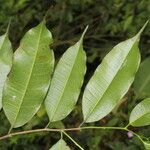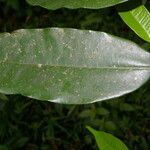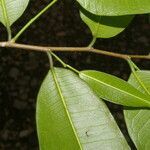A tree. It grows 40 m high. It has white latex. The bark peels off revealing orange. The male flowering shoots are usually in pairs. The fruit is oval or pear shaped. It is 4 cm long by 2.3 cm wide. It can be yellow, orange or red. The fruit stalk is fleshy and edible. The seeds are narrowly oval and 2.8 cm long by 1.8 cm wide. They are fairly soft.




